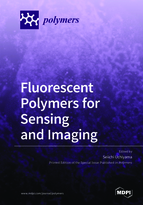Fluorescent polymers for sensing and imaging
A special issue of Polymers (ISSN 2073-4360). This special issue belongs to the section "Polymer Applications".
Deadline for manuscript submissions: closed (20 June 2019) | Viewed by 65122
Special Issue Editor
Special Issue Information
Dear Colleagues,
Nowadays, all scientists recognize that fluorescent probes play important roles in wide research areas, from chemistry to biology. By combining this fact with specific functional benefits from synthetic polymers, fluorescent polymeric probes are occasionally superior to small organic and inorganic fluorescent (or luminescent) probes in terms of sensitivity, robustness, and multiple functionality. For instance, exceptional sensitivity is conquered by either an amplification effects with concentrated fluorophores in a polymer particle or utilization of a stimulus-responsive polymer. The targets of fluorescent polymeric probes have extended from chemical species (e.g., ions and molecules) to physical parameter (e.g., temperature and viscosity). In addition to an environmental analysis with a glass cuvette or a microplate, biological cells are the spaces where the fluorescent polymeric probes extensively work. The ability to enter living cells and non-cytotoxicity are possible advantages of fluorescent polymeric probes in biological applications.
This Special Issue is a platform for all researches to develop a novel fluorescent polymeric probe and to establish a new analytical method using a conventional fluorescent polymeric probe. Related researches, e.g., fluorometric investigation of functional polymers, are also welcome. Well-balanced review articles with personal viewpoints are another encouraged contribution to the Special Issue.
Dr. Seiichi Uchiyama
Guest Editor
Manuscript Submission Information
Manuscripts should be submitted online at www.mdpi.com by registering and logging in to this website. Once you are registered, click here to go to the submission form. Manuscripts can be submitted until the deadline. All submissions that pass pre-check are peer-reviewed. Accepted papers will be published continuously in the journal (as soon as accepted) and will be listed together on the special issue website. Research articles, review articles as well as short communications are invited. For planned papers, a title and short abstract (about 100 words) can be sent to the Editorial Office for announcement on this website.
Submitted manuscripts should not have been published previously, nor be under consideration for publication elsewhere (except conference proceedings papers). All manuscripts are thoroughly refereed through a single-blind peer-review process. A guide for authors and other relevant information for submission of manuscripts is available on the Instructions for Authors page. Polymers is an international peer-reviewed open access semimonthly journal published by MDPI.
Please visit the Instructions for Authors page before submitting a manuscript. The Article Processing Charge (APC) for publication in this open access journal is 2700 CHF (Swiss Francs). Submitted papers should be well formatted and use good English. Authors may use MDPI's English editing service prior to publication or during author revisions.
Keywords
- Fluorescence
- Polymer
- Gel
- Nanoparticles
- Ion
- Live cell imaging
- Luminescence







